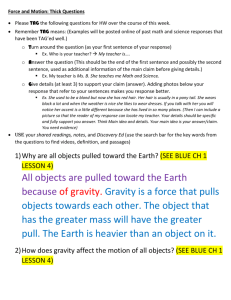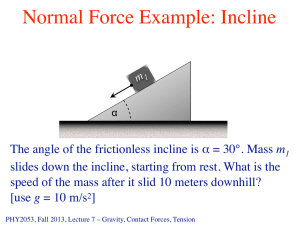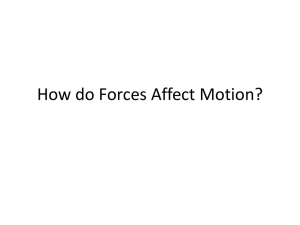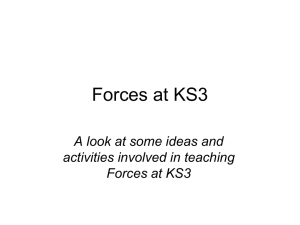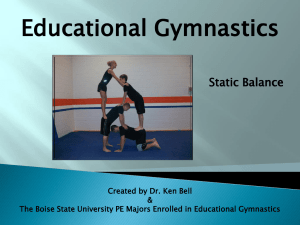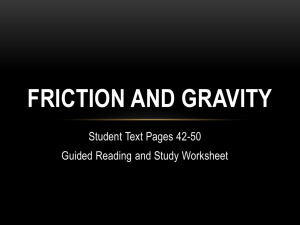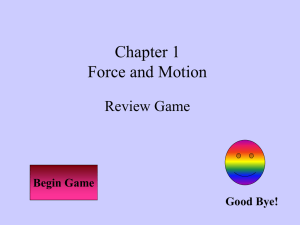balance
advertisement
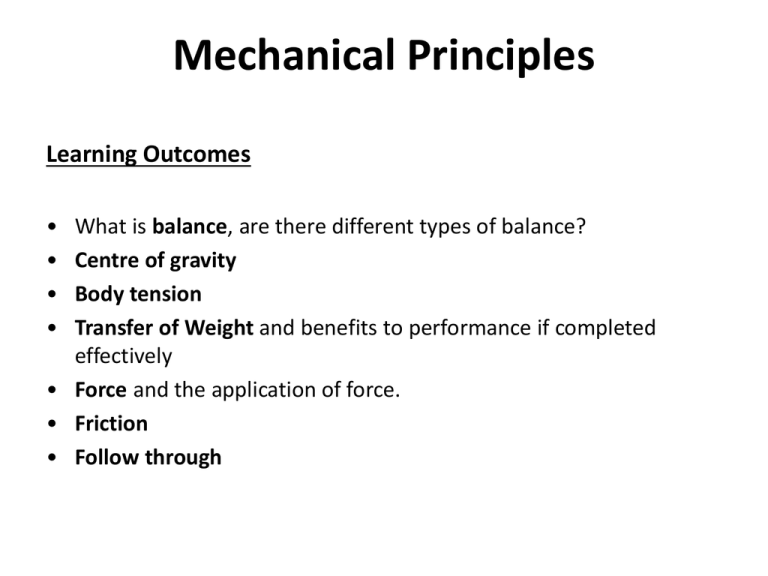
Mechanical Principles Learning Outcomes • • • • What is balance, are there different types of balance? Centre of gravity Body tension Transfer of Weight and benefits to performance if completed effectively • Force and the application of force. • Friction • Follow through Balance Balance is the ability to retain the centre of gravity over your base of support. There are two types of balances: 1) Static balances 2) Dynamic balances Centre of Gravity Centre of gravity is to do with stability. i. The heavier you are, the more stable you will be ii. To be balanced your centre of gravity should be inside your base iii.A low position with a wide base is more balanced Centre of Gravity Balance Homework 5 Body Tension For technique to be effective it is helpful if the major muscles involved in balances have good body tension. In gymnastics explain how good body tension helped to improve the quality of your balances? Transfer Of Weight The transfer of weight allows you to move your body from one place to another. How well you transfer your weight involves considering how well balanced you are when performing. To transfer your weight in any direction, you must apply a force in the opposite direction. The force is created when you contract your muscles. At times, this can be single actions such as throwing the javelin. At other times, for example when running, simple actions are repeated. Name 2 activities, describe one technique which requires a single transference of weight and describe another technique which requires repeated transference of weight Application of Force When performing different skills and techniques different forces are applied and resisted. For every action there is an equal and opposite reaction (Newton’s third law) Application of Force If speed is required then the greater force applied the better. Differences in the mass of the body will affect performance. If the force applied to the sprinting block (100m sprint) is the same the athlete with a smaller mass will accelerate at a quicker rate. Application of Force If speed is required then the greater force applied the better. Differences in the mass of the body will affect performance. If the force applied to the sprinting block (100m sprint) is the same the athlete with a smaller mass will accelerate at a quicker rate. Force You must apply force in one direction to move in the opposite direction. Look at the following examples. Explain where force is applied and what direction the person or equipment moves. B A. C Friction This is when contact between two surfaces cause a slowing down or gripping effect. This can be an advantage or disadvantage depending on the activity and the skill or technique you are trying to complete. Adv. Football boots getting a good grip on the ground to stop the player slipping and allow them to change direction quickly DisAdv. In cycling when the wind slows you down Choose four activities explain how friction affects your performance. Rotation In different activities you rotate (turn) in order to carry out skills and techniques. When throwing the discus in athletics you turn around in a spinning back-to-front movement to generate power. This is a complex technique. You build up speed before throwing by quickly turning until you have regained balance. You can also rotate by performing a forward roll. Name two skills in which you turn head over heals. Resistance When you apply force there will be resistance. Like friction, resistance can either be an advantage or disadvantage. Adv. When sprinting in athletics the starting blocks are an advantage. They provide resistance. DisAdv. If you are running into a headwind this slows you down. Resistance can be reduced or increased depending on your technique. In swimming if you keep your head out of the water when doing the front crawl this creates a greater resistance with the water and slows you down. Reduce resistance by putting head level with the water (streamlined) Follow through When completing different skills and techniques it is important to have a good follow through. A good follow through is part of effective performance and follows on from the preparation and action phases in different skills and techniques. An example would be kicking a ball in football, the follow through is in the direction of the shot. In other actions the follow through involves body rotation. The ball and socket joints in the hips and shoulder help rotation in this striking action. Mechanical Principles A. What is the importance of transfer of weight when completing an ‘overhead clear’? B. When completing a ‘headstand’ what affect would having a small base have your performance? C. Why is body tension important when completing static balances? D. Where must your centre of gravity be maintained to hold a balance? E. Give an example of a dynamic balance? F. Name two activities where equipment is used to reduce friction? G. In swimming, how did improving your technique, reduce your resistance in the water? H. Describe one technique in three different activities where follow through is important (use kicking, striking and throwing)?
